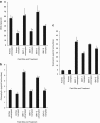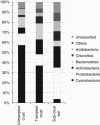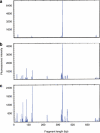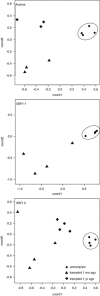Response and resilience of soil biocrust bacterial communities to chronic physical disturbance in arid shrublands
- PMID: 22113374
- PMCID: PMC3309361
- DOI: 10.1038/ismej.2011.153
Response and resilience of soil biocrust bacterial communities to chronic physical disturbance in arid shrublands
Abstract
The impact of 10 years of annual foot trampling on soil biocrusts was examined in replicated field experiments at three cold desert sites of the Colorado Plateau, USA. Trampling detrimentally impacted lichens and mosses, and the keystone cyanobacterium, Microcoleus vaginatus, resulting in increased soil erosion and reduced C and N concentrations in surface soils. Trampled biocrusts contained approximately half as much extractable DNA and 20-52% less chlorophyll a when compared with intact biocrusts at each site. Two of the three sites also showed a decline in scytonemin-containing, diazotrophic cyanobacteria in trampled biocrusts. 16S rRNA gene sequence and terminal restriction fragment length polymorphism (T-RFLP) analyses of soil bacteria from untrampled and trampled biocrusts demonstrated a reduced proportion (23-65% reduction) of M. vaginatus and other Cyanobacteria in trampled plots. In parallel, other soil bacterial species that are natural residents of biocrusts, specifically members of the Actinobacteria, Chloroflexi and Bacteroidetes, became more readily detected in trampled than in untrampled biocrusts. Replicate 16S rRNA T-RFLP profiles from trampled biocrusts at all three sites contained significantly more fragments (n = 17) than those of untrampled biocrusts (n≤6) and exhibited much higher variability among field replicates, indicating transition to an unstable disturbed state. Despite the dramatic negative impacts of trampling on biocrust physical structure and composition, M. vaginatus could still be detected in surface soils after 10 years of annual trampling, suggesting the potential for biocrust re-formation over time. Physical damage of biocrusts, in concert with changing temperature and precipitation patterns, has potential to alter performance of dryland ecosystems for decades.
Figures




References
-
- Barger N, Herrick J, Van Zee J, Belnap J. Impacts of biological soil crust disturbance and composition on C and N loss from water erosion. Biogeochemistry. 2006;77:247–263.
-
- Bates S, Garcia-Pichel F. A culture-independent study of free-living fungi in biological soil crusts of the Colorado Plateau: their diversity and relative contribution to microbial biomass. Environ Microbiol. 2009;11:56–67. - PubMed
-
- Bauer M, Kube M, Teeling H, Richter M, Lombardot T, Allers E, et al. Whole genome analysis of the marine Bacteroidetes ‘Gramella forsetii' reveals adaptations to degradation of polymeric organic matter. Environ Microbiol. 2006;8:2201–2213. - PubMed
-
- Belnap J. Surface disturbances: their role in accelerating desertification. Environ Monit Assess. 1995;37:1–19. - PubMed
-
- Belnap J. Impacts of off-road vehicles on nitrogen cycles in biological soil crusts: resistance in different US deserts. J Arid Environ. 2002;52:155–165.
Publication types
MeSH terms
LinkOut - more resources
Full Text Sources
Other Literature Sources
Molecular Biology Databases

